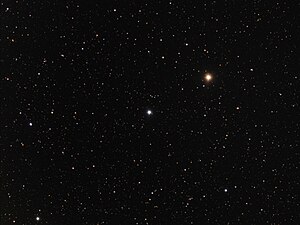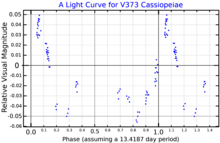 V373 Cassiopeiae (center) in optical light. The bright yellow star to the upper right of V373 Cas is ρ Cas. | |
| Observation data Epoch J2000 Equinox J2000 | |
|---|---|
| Constellation | Cassiopeia |
| Right ascension | 23 55 33.83878 |
| Declination | +57° 24′ 43.8057″ |
| Apparent magnitude (V) | 6.03 |
| Characteristics | |
| Spectral type | B0.5II + B4III/V |
| B−V color index | 0.155±0.005 |
| Variable type | Eclipsing? |
| Astrometry | |
| Radial velocity (Rv) | −25.5±0.9 km/s |
| Proper motion (μ) | RA: −4.098 mas/yr Dec.: −0.101 mas/yr |
| Parallax (π) | 0.5267 ± 0.0583 mas |
| Distance | approx. 6,200 ly (approx. 1,900 pc) |
| Orbit | |
| Period (P) | 13.41921 days |
| Eccentricity (e) | 0.126±0.019 |
| Periastron epoch (T) | 2,420,801.98 JD |
| Argument of periastron (ω) (secondary) | 16±8° |
| Semi-amplitude (K1) (primary) | 106.7±2.7 km/s |
| Semi-amplitude (K2) (secondary) | 144.6±2.6 km/s |
| Details | |
| A | |
| Mass | 18.6±2.4 M☉ |
| Surface gravity (log g) | 3.0±0.2 cgs |
| Temperature | 23,200±600 K |
| Rotational velocity (v sin i) | 130±10 km/s |
| Age | 7–8 Myr |
| B | |
| Mass | 14.2±1.9 M☉ |
| Surface gravity (log g) | 3.5±0.2 cgs |
| Temperature | 26,800±1,500 K |
| Rotational velocity (v sin i) | 60±5 km/s |
| Other designations | |
| V373 Cas, BD+56°3115, GC 33184, HD 224151, HIP 117957, HR 9052, SAO 35899 | |
| Database references | |
| SIMBAD | data |
V373 Cas is a binary star system in the northern constellation Cassiopeia. It is a suspected eclipsing binary with an apparent visual magnitude that decreases from a baseline of 6.03 down to 6.13. The system is located at a distance of approximately 6,200 light years from the Sun, but is drifting closer with a radial velocity of around −25.5 km/s.

The binary nature of this system was announced in 1912 by Walter S. Adams. It is a double-lined spectroscopic binary with an orbital period of 13.4 days and an eccentricity of 0.13. The system was found to be variable in 1958 by C. Roger Lynds, and the variability cycle was shown to be related to the orbital period. It has been described as a heartbeat star rather than an eclipsing system. This is a type of pulsating star where the pulsations are induced by the tidal attraction of a close companion.
V373 Cas is composed of two hot blue-white giant stars that have exhausted their core hydrogen and expanded off the main sequence. Lyubimkov and colleagues analysed spectral and radial velocity to calculate that the stars were ~19 and ~15 times as massive as the Sun and the age of the system is around 7-8 million years old. The primary component is the more evolved and now comes close to filling its Roche lobe when it is at periastron.
References
- ^ Brown, A. G. A.; et al. (Gaia collaboration) (August 2018). "Gaia Data Release 2: Summary of the contents and survey properties". Astronomy & Astrophysics. 616. A1. arXiv:1804.09365. Bibcode:2018A&A...616A...1G. doi:10.1051/0004-6361/201833051. Gaia DR2 record for this source at VizieR.
- ^ Anderson, E.; Francis, Ch. (2012). "XHIP: An extended hipparcos compilation". Astronomy Letters. 38 (5): 331. arXiv:1108.4971. Bibcode:2012AstL...38..331A. doi:10.1134/S1063773712050015. S2CID 119257644.
- ^ Samus, N. N.; et al. (2017). "General Catalogue of Variable Stars". Astronomy Reports. 5.1. 61 (1): 80–88. Bibcode:2017ARep...61...80S. doi:10.1134/S1063772917010085. S2CID 125853869.
- ^ Wilson, R. E. (1953). "General Catalogue of Stellar Radial Velocities". Carnegie Institute Washington D.C. Publication. Bibcode:1953GCRV..C......0W.
- ^ Hill, G.; Fisher, W. A. (January 1987). "Studies of early-type variable stars. IV. The orbit and physical dimensions for V373 Cas". Astronomy and Astrophysics. 171: 123–130. Bibcode:1987A&A...171..123H.
- ^ Lyubimkov, L. S.; et al. (1998). "The binary system V373 Cas: orbital elements, parameters of the components, and helium abundance". Astronomy Reports. 42 (3): 312–321. Bibcode:1998ARep...42..312L.
- "V373 Cas". SIMBAD. Centre de données astronomiques de Strasbourg. Retrieved 2020-11-19.
- Lynds, C. R. (September 1959). "The Light-Variation of HD 224151". Astrophysical Journal. 130: 599–602. Bibcode:1959ApJ...130..599L. doi:10.1086/146748.
- ^ Lynds, C. R. (September 1959). "The Light-Variation of HD 224151". Astrophysical Journal. 130: 599. Bibcode:1959ApJ...130..599L. doi:10.1086/146748.
- "V0373 Cas". Retrieved 2020-11-20.
- Karami, K.; Mohebi, R. (December 2009). "Velocity curve studies of spectroscopic binary stars V380 Cygni, V401 Cyg, V523 Cas, V373 Cas and V2388 Oph". Journal of Astrophysics and Astronomy. 30 (3–4): 153–163. Bibcode:2009JApA...30..153K. doi:10.1007/s12036-009-0010-0. S2CID 122334785.
| Constellation of Cassiopeia | |||||||||||||
|---|---|---|---|---|---|---|---|---|---|---|---|---|---|
| Stars |
| ||||||||||||
| |||||||||||||
| |||||||||||||
| Nebulae |
| ||||||||||||
| Galaxies |
| ||||||||||||
| |||||||||||||